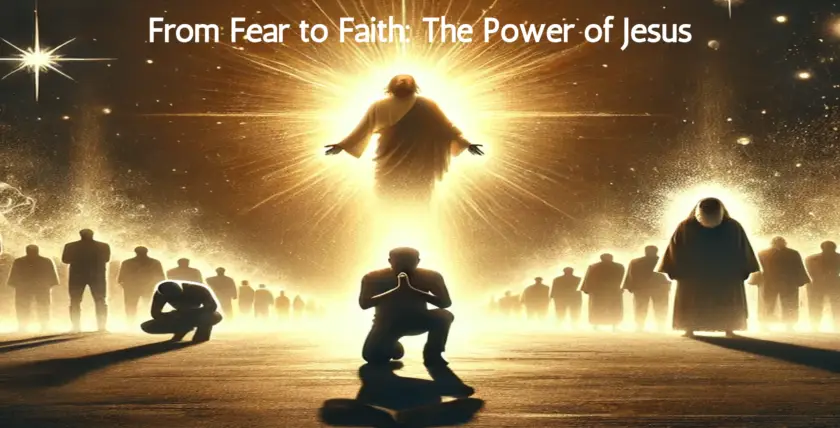We’ve been exploring the angelic powers revealed in the Bible, which help us understand the character and nature of God. These angelic powers are essential to our knowledge of God because, as scripture tells us, God is Spirit—and Spirit is invisible. Through the interactions of these angelic powers with humanity, we can see the attributes of an unseen God reflected in them.
In ancient Jewish culture, these expressions of God were symbolized by the seven-branched Menorah in the Tabernacle, representing the Seven Spirits of God. As we discuss the seventh angelic power—Satan, meaning “The Adversarial spirit”—we recognize that adversity plays a critical role in creating faith and strengthening humanity’s trust in God. Opposition and challenges are integral to God’s plan to establish an eternal, harmonious relationship with His children – strength through challenge.
Paul affirmed this truth to the suffering believers in Rome when he wrote in Romans 8:28. Therefore, Satan – adversity- is instrumental in God’s plan for us to spend eternity with him. But that’s not how Satan is presented to us, either as believers in Christ or unbelievers. For us to truly understand Satan’s role, we must first remove the common modern cultural fallacies about Satan. To understand Satan fully, we must first set aside our cultural myths about him.
1 Satan is the ruler of hell: Contrary to popular belief, Satan does not oversee the torment of souls in hell. This imagery stems from medieval art and literature like Dante’s Inferno, not the Bible. Scripture clearly states that God will destroy Satan by fire (Revelation 20:10)— Satan doesn’t live in the lake of fire; the adversary is destroyed there.
2 Satan resides in purgatory: The concept of purgatory is unbiblical and was historically used to generate financial support for the church. Jesus died for all sins, not just some. There’s no need for purgatory—and no role for Satan there.
3 Satan has horns, a tail, and a pitchfork: These depictions are medieval fantasy. As a spiritual being, Satan has no physical form, and the Bible provides no physical description of him.
4 Satan can read minds: Satan isn’t omniscient. He doesn’t know our thoughts. His knowledge is limited to observation. As Psalm 139:3-4 says, only God knows our secrets.
5 Satan is omnipresent: It’s believed the devil is everywhere at the same time tempting people. No scripture says he is. Satan’s influence is present throughout the world, but he isn’t present. In Job 1:7, God asks him what he’s been up to, and he says he’s been roaming around the world.
6 Satan causes all sin: The Bible holds humans accountable for our sins. Satan may lie and deceive us, but the choice to sin is ours, as Romans 5:12 says. We can’t use the excuse, “The devil made me do it.” How could God hold us accountable for sin if Satan made us sin? The serpent in the garden didn’t “make” Adam and Eve sin. Their sin was their own. The serpent gave them something to consider, but they chose their actions.
7 Satan causes all illness and suffering: This is false. I’m going to talk more about demon possession and how some attribute illness to Satan and demons in a future episode. But here, I’ll say that sickness and suffering result from living in a fallen world (Romans 8:20-21).
8 Satan is God’s equal opponent: Satan is a created being, not God’s equal. The Bible refutes “cosmic dualism,” affirming God’s sovereignty over all, including Satan (Isaiah 45:7).
9 Satan’s power is overwhelming: Peter assures us we can resist Satan’s temptations in 1 Peter 5:8-9. He can’t force anyone to sin.
10 Satan was cast from heaven before creation: The rebellion described in Isaiah 14 [King of Babylon] and Ezekiel 28 [King of Tyre] is often interpreted symbolically or theologically, but it’s not tied to a precreation event.
11 Satan leads fallen angels: Satan is portrayed as the leader who leads other angels to rebel against God. An angelic rebellion is described in Revelation, but details about how and why the uprising happened aren’t given. The majority of information about Satan leading a group of angels against God is from extrabiblical writings.
12 Satan isn’t real: Some view Satan as merely symbolic. However, scripture consistently portrays him as a real, active adversary. As I’ve explained previously, Satan – ha satan – the adversary or deceiver has a role within God’s hierarchy of angelic powers. We see an angelic Satan testing Jesus in the wilderness. Still, we also see the influence of the adversarial role when Jesus called Peter Satan in Matthew 16:23. The spiritual influence of opposition to God in the world is very real. The negative impact of adversity and deception against every human is very real.
Many of our misconceptions about Satan arise from cultural myths, Greek philosophy, extrabiblical writings, medieval and modern artist fantasy, and speculative theology. These ideas often perpetuate fear and even serve financial agendas. Let’s call it as it is: the Devil is a moneymaker. Create a boogeyman like an all-powerful evil villain, call him the devil, and use him to strike fear in people’s lives and get rich.
In truth, Satan’s role is limited and temporary. God controls his activity, and Jesus has already defeated him through the resurrection. The writer of Hebrews tells us this in Hebrews 2:14. The sting of death is sin, the power of sin is the law, and the power of death is fear. You can’t sell Satan your soul. Only God has the power to condemn or give life. Today, Satan’s power lies in ignorance and unbelief. Not ignorance and unbelief in Satan, but ignorance about God and unbelief in Jesus Christ. Let us cling to God’s Word and resist the devil, knowing that victory is already ours through Christ!


